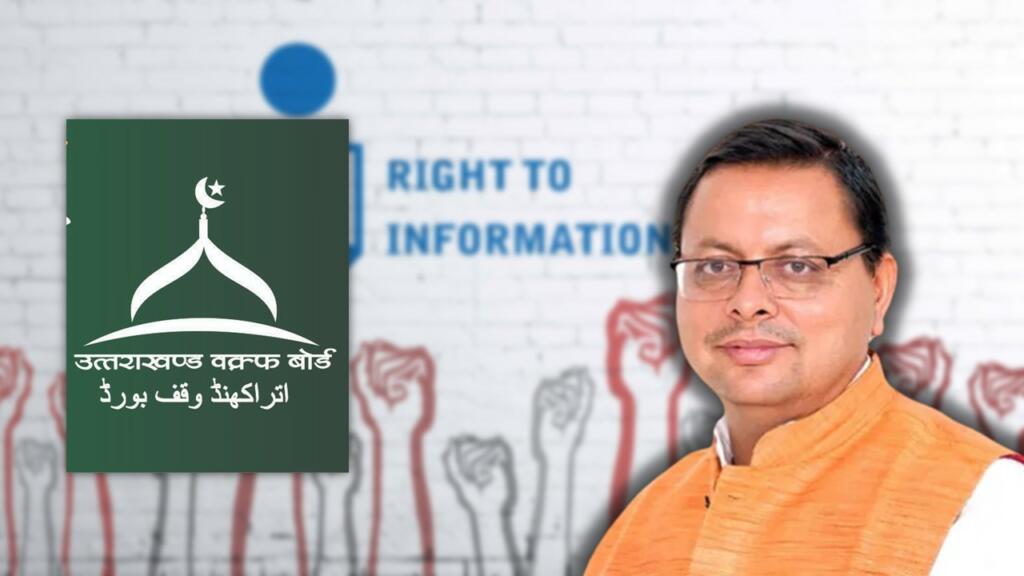Uttarakhand Waqf Board: The Uttarakhand BJP government has taken a significant step in ensuring transparency and accountability by including all Waqf properties within the state’s jurisdiction under the Right to Information (RTI) Act. This decision opens the doors for citizens to access comprehensive information about these properties, shedding light on their finances, operations, and more.
The move to bring Waqf properties under the RTI Act stems from a lack of transparency regarding the vast number of properties and their associated funding controlled by the Waqf Board in Uttarakhand. With around 2200 Waqf properties registered with the Uttarakhand Waqf Board, this decision is indeed a bold one, considering the historical inconsistencies in presenting records and the substantial influence these properties have had on Uttarakhand’s demographic landscape.
Uttarakhand BJP Government has decided to bring all Waqf properties in the state under the ambit of Right to Information (RTI) Act.
The Waqf Board in Uttarakhand is governed by the Waqf Act 1995, which was amended in 2013 and 2020.
The amendment of 2020 is related to the… pic.twitter.com/QuQeXfZ7yG
— Sahil Mahajan साहिल महाजन (@SahilRMahajan) October 26, 2023
Also read: Allahabad HC nails Waqf Board over Shri Krishna Janmbhoomi case
To understand the significance of this decision, let’s first delve into what the Waqf Board is and how the RTI Act empowers citizens.
The Waqf Board in Uttarakhand operates under the purview of the Waqf Act 1995, with amendments made in 2013 and 2020. The 2020 amendment specifically deals with the lease of Waqf properties. The primary purpose of the Waqf Board is to manage properties donated for religious and charitable purposes. Over the years, it has become crucial for the socio-economic development of the Muslim community and the public at large.
On the other hand, the Right to Information (RTI) Act, 2005, empowers citizens to request information from public authorities, including government organizations and statutory bodies like the Waqf Board. Under the RTI Act, citizens have the right to access information about the functioning, finances, and activities of these organizations.
One of the central reasons behind bringing Waqf properties under the RTI Act is the lack of transparency surrounding their operations. These properties often generate income through various means, and how this money is utilized has remained largely opaque. With the new decision in place, all information about income, expenditure, and ongoing activities will now be made accessible to the public.
The move follows a recent order from the State Information Commission (SIC) directing the management of Roorkee’s Piran Kaliyar dargah to provide information sought under the RTI Act. The SIC emphasized that as a statutory body, the dargah could not refuse to provide information under the RTI Act. This serves as a precedent and highlights the Uttarakhand government’s commitment to ensuring transparency in the functioning of organizations like the Waqf Board.
This decision is pivotal not only because of the newfound transparency it brings but also because of the critical role played by Waqf properties in Uttarakhand’s demographic landscape. Over the years, there have been concerns about the demographic changes resulting from the acquisition and utilization of these properties.
By bringing Waqf properties under the ambit of the RTI Act, citizens and stakeholders can gain insight into how these properties are managed, funded, and the impact they have on the state’s social fabric. This information can help dispel misconceptions, ensure equitable distribution of resources, and foster a sense of inclusivity among all communities.
Also read: High Court sought justice after its own land was snatched by Waqf Board
The inclusion of Waqf properties in the RTI Act will undoubtedly promote accountability and transparency in their functioning. Here are some key aspects that will now be open for public scrutiny:
- Property Details: Citizens can access comprehensive information about each Waqf property, including its location, size, purpose, and current status.
- Financial Records: Details of the income generated from these properties, such as rents, donations, and investments, will be made available. Additionally, information on how these funds are allocated and spent can be accessed.
- Development and Welfare Activities: Information about the various developmental and welfare activities conducted by the Waqf Board will be accessible. This includes initiatives that benefit the local community.
- Lease Details: The 2020 amendment to the Waqf Act focused on the lease of Waqf properties. With the inclusion of these properties under the RTI Act, citizens can access information about lease agreements and their terms.
- Impact on Demographics: Transparency in the functioning of Waqf properties can help address concerns related to demographic changes. Accessible data will facilitate informed discussions and policy decisions.
The inclusion of all Waqf properties within Uttarakhand’s jurisdiction under the Right to Information (RTI) Act is a significant step forward in ensuring transparency and accountability. This bold move addresses long-standing concerns about the lack of information regarding the vast number of properties controlled by the Waqf Board and their impact on the state’s demographic landscape.
Support TFI:
Support us to strengthen the ‘Right’ ideology of cultural nationalism by purchasing the best quality garments from TFI-STORE.COM.
